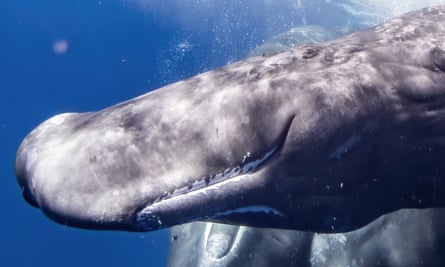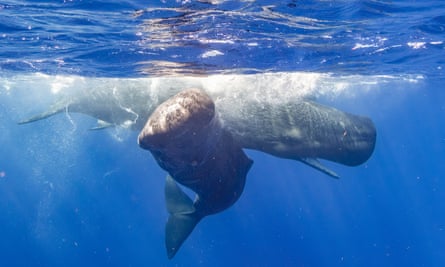Sperm whales are among the deepest divers on the planet. They are natural submarines, spending 70% of their time foraging for squid in the dark ocean for up to 80 minutes at a time. When they break through what Herman Melville called “the ocean’s skin”, they socialise, twisting and turning their grey bodies around one another in a sensual, enigmatic choreography.
They measure up to 18 metres long and have the biggest brains on Earth. For at least 200 years, scientists have wondered what these mammals do with those brains. Now, evidence has emerged that may revolutionise the way we think about whales.
The authors of a new paper in the Proceedings of the National Academy of Sciences journal have presented evidence that sperm whales’ culture is characterised by “symbolic marking”.
In humans, symbolic marking such as clothing choice, hairstyle or tattoos shows “who one is inside on the outside”. It is implicit in what we wear, how we look, how we speak. Sperm whales, to express their culture, emit loud staccato clicks from their head, scientists have found.
Otherwise used to echolocate prey, these sounds can take the form of emitted morse code-like sequences that the scientists call “identity codas”. When different clans of whales come together, they appear to use these codas to identify themselves. They are saying: this is us.

The paper’s authors believe this is a social exchange, like a human conversation. “The signal can either be received by, or directed at, members of the same group (us) or members of different groups (them), or both,” Hal Whitehead, one of the authors, told the Guardian.
Whitehead said the new data suggested “the presence of other groups (clans) affects the symbols” – an audible demonstration of ethnic diversity in another species, and proof that social marking is not unique to humans.
The paper identifies seven whale clans in the Pacific Ocean whose discrete identity codas “serve functions within the umbrella of social bonding, similar to human music”.
Their clicks represent whale taste, as much as human taste is expressed in fashion, hairstyles or piercings that advertise what group we identify with. The whales are not only identifying themselves to their own clan, but also are signalling their clanship to others in aural tattoos.
Dr Taylor Hersh, the paper’s primary author, said the work showed “compelling, quantitative evidence” that identity codas were used in this way by whales. “A clear human analogy,” she said, “is that if you see someone wearing a necklace with a cross on it or a star of David, you know just from looking at that symbol something about a group the person considers themselves to be a member of.”
Perhaps the most important conclusion is that these interactions have a defining, evolutionary aspect. “In humans, as cultural groups overlap more and more, we see more and more emphasis on these symbols. The same seems to be happening with the sperm whales,” said Hersh.
As to what those clicks might mean – well, we may be about to find out. In his new book, How to Speak Whale, published this week, the film-maker Tom Mustill discusses new advances that indicate we might, in the near future, be able to “translate” whale communication, using a complex series of underwater listening systems to concentrate on a specific sperm whale pod and determine exactly how they react, audibly, to different situations, such as changes in weather, food sources, and social behaviour of their pod members.
By linking the sounds that the whales are making with what they are doing at the time, Mustill says, the newly founded Cetacean Translation Initiative (Ceti) hopes to provide a comprehensive set of data, from which AI analysis can establish the meaning of the clicks.

Ceti will then use whale “chatbots” to predict what the animals will say in certain situations and, in a science-fiction leap, attempt “bidirectional communication” – that is, talk back to the whales. It’s a scenario out of 2001: A Space Odyssey, only with the alien whine of a black monolith replaced by the sonar click of a grey leviathan.
In 1970, recordings of humpback whale song proved to be the trigger that led to the successful Save the Whales campaigns of the 70s and 80s. Whale song opened our ears to the presence of a culture other than ours. Now, these revelations about the aural culture of whales may be another gamechanger in our relationship with the rest of the natural world. It’s our Doctor Dolittle moment.
We may be about to converse with whales. But the big question is: what are they going to say?
Did you know …?
Sperm whales are named after the semi-liquid waxy substance in their heads called spermaceti, which is part of the process that makes their clicking sounds. It is so named because early biologists mistakenly assumed the substance was the whales’ semen.
They are usually found in deep open waters. Females tend to remain between 40 degrees south and 40 degrees north, while males venture into latitudes as high as the 70s in both north and south. Their ranges are expanding as the world’s oceans heat up.
They can compress their ribcages and collapse their lungs in order to withstand the pressure while feeding, often at depths of about 800m.
To defend themselves from attack, they have been known to use a formation called the marguerite, in which they form a wagon wheel shape with their heads in the middle. They then use their tails to swipe at their attackers.
Through their history, sperm whales have been heavily hunted for substances including ambergris, a waxy substance that forms around squid beaks in the whales’ digestive systems and is widely used in perfumes.
